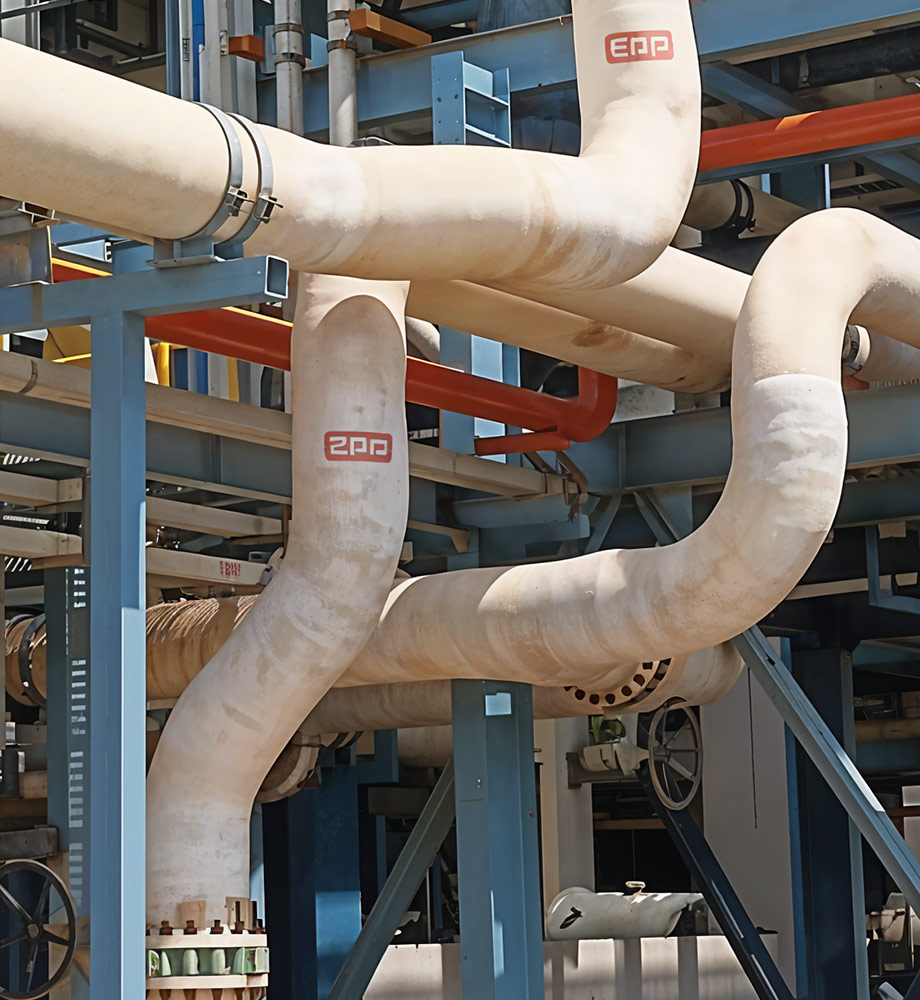Key Features
- Corrosion Resistance: FRP pipe and fittings need no internal linings or cathodic protection – the composite inherently withstands acids, alkalis, salts and oxidizers.
- High Strength-to-Weight: FRP offers metal-like pressure ratings at a fraction of the weight. This simplifies handling and support design and speeds up installation.
- Lightweight Construction: At only ~20% the weight of steel or 10% of reinforced concrete, FRP piping is easy to ship and install.
- Smooth Flow Surface: The fiberglass-reinforced bore is very smooth, yielding high hydraulic efficiency (low friction losses).
- Large Diameter & Long Lengths: Available in diameters from ≈15 mm to 4000 mm, FRP pipes can be produced in long, continuous sections (often tens of meters), reducing joints and leak paths.
- Versatile Fabrication: Pipes and fittings are made by filament winding, contact molding or centrifugal casting. Flanged, butt-welded (FRP and metal), and flared-end joints are common. GRP/FRP fittings include any angle or branch needed (45°/90° bends, tees, crosses, reducers, etc.) manufactured to order.
- Thermoplastic Liner Option: For extra chemical safety, FRP pipes can be lined with engineered plastics (PP, PVC, CPVC, PVDF, ECTFE, FEP, PFA, etc.) to form a dual-laminate system.
Benefits
- Ultra-Long Service Life: FRP composites do not corrode or scale, often yielding 30–50 years of maintenance-free service.
- Low Maintenance: No painting, wrapping or cathodic protection is needed. If using a conductive liner, leaks are easy to detect. Smooth inner surfaces resist fouling, reducing cleaning.
- Lower Lifecycle Cost: The initial material cost is offset by decades of corrosion-free operation, minimal downtime, and lower support and foundation requirements (due to lightweight construction).
- Safety & Inertness: FRP is non-sparking and electrically non-conductive (unless conductive layer added). It poses no risk of metal contamination or rust, making it ideal for pure process fluids and potable water.
- Design Flexibility: Custom FRP systems can incorporate drains, venting ports, and instrumentation. Complex plant layouts are easier with FRP’s long-length, joint-minimized design and light weight.
Applications
FRP process piping is ideal for highly corrosive fluid transfer and effluent handling. Typical industries include chemical and petrochemical processing, water and wastewater treatment (including desalination), pulp & paper, mining leachates, and power plants (acid/alkali service in scrubbers and cooling systems). FRP is also used in marine or seawater applications (corrosion-resistant saltwater piping), pharmaceutical, and food/beverage (non-contaminating polypropylene-lined FRP), as well as HVAC and ventilation ductwork. In all these environments, FRP’s resistance to acids, alkalis, and salts is a major advantage.
Technical Specifications
- Materials: Fiberglass-reinforced thermoset (vinylester, isophthalic/polyester, epoxy, etc.); optional thermoplastic liners (PP, PVC, CPVC, PVDF, ECTFE, FEP, PFA, etc.).
- Diameter Range: Commonly 15 mm to 4000 mm (GRE up to 4000 mm). FRP pipes typically 50–2500 mm; ultra-large up to 3500 mm are possible. FRP fittings cover all corresponding sizes with flanged ends.
- Pressure Rating: Standard FRP piping up to ~60 bar (6000 kPa) at ambient temperature; specialized glass-reinforced epoxy (GRE) piping can reach ~400 bar for high-pressure service.
- Temperature Limits: Depend on resin/liner (e.g. polyester ~60–80°C, vinylester ~100–150°C, epoxies and phenolics higher). With specialized resins or liners, handling hot acids up to ~200–250°C is feasible.
- Standards: Manufactured per DIN/BS/ASTM/JIS/AWWA/IS or customer specs. Pipe flanges per ANSI B16.5/ASME B16.47, or custom for FRP. Pressure ratings often follow ASTM D2996 (GRE) or AWWA C950 (FRP with O-ring joints).
- Welded Fittings: In-house fabrication covers bends, tees, reducers in single-piece construction (often by filament winding) to avoid field welding of FRP (sunrise notes single-piece molding for lifetime durability).
- Certification: Many FRP manufacturers hold ISO 9001, and products can meet fire retardancy (UL 94 V-0/5VA) or UV protection requirements as needed.
Unique Selling Points (USPs)
- Corrosion Immunity: FRP pipes/fittings never rust or pit, eliminating leaks and pipe replacements in corrosive service.
- Extraordinarily Long Life: Well-made FRP piping can reliably last several decades (Sunrise cites design lives up to 10–50 years, and lightweight systems up to 50+ years).
- Light & Easy Installation: At ~20% the weight of steel, FRP systems reduce lifting costs and allow quicker, safer installations with fewer supports.
- Smooth, Leak-Tight Joints: High-quality O-ring or gasket joints (or butt-welded thermoplastic liners) ensure no infiltration/exfiltration. The smooth inner walls and strong joints give excellent flow and prevent leaks.
- Custom Engineered Systems: Every FRP piping layout is custom-built. Manufacturers can integrate flanges, sight glasses, instrumentation ports, drip pans, or support saddles. Single-piece molding (no field joints) yields a mirror-smooth bore.
- Chemical & Temperature Tailoring: By selecting specific resins and liners, FRP systems can be optimized for virtually any aggressive chemical or temperature requirement, offering broader service than standard plastics or coated metals.

